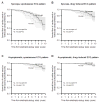Programmed Ventricular Stimulation for Risk Stratification in the Brugada Syndrome: A Pooled Analysis
- PMID: 26797467
- PMCID: PMC4758872
- DOI: 10.1161/CIRCULATIONAHA.115.017885
Programmed Ventricular Stimulation for Risk Stratification in the Brugada Syndrome: A Pooled Analysis
Abstract
Background: The role of programmed ventricular stimulation in identifying patients with Brugada syndrome at the highest risk for sudden death is uncertain.
Methods and results: We performed a systematic review and pooled analysis of prospective, observational studies of patients with Brugada syndrome without a history of sudden cardiac arrest who underwent programmed ventricular stimulation. We estimated incidence rates and relative hazards of cardiac arrest or implantable cardioverter-defibrillator shock. We analyzed individual-level data from 8 studies comprising 1312 patients who experienced 65 cardiac events (median follow-up, 38.3 months). A total of 527 patients were induced into arrhythmias with up to triple extrastimuli. Induction was associated with cardiac events during follow-up (hazard ratio, 2.66; 95% confidence interval [CI], 1.44-4.92, P<0.001), with the greatest risk observed among those induced with single or double extrastimuli. Annual event rates varied substantially by syncope history, presence of spontaneous type 1 ECG pattern, and arrhythmia induction. The lowest risk occurred in individuals without syncope and with drug-induced type 1 patterns (0.23%, 95% CI, 0.05-0.68 for no induced arrhythmia with up to double extrastimuli; 0.45%, 95% CI, 0.01-2.49 for induced arrhythmia), and the highest risk occurred in individuals with syncope and spontaneous type 1 patterns (2.55%, 95% CI, 1.58-3.89 for no induced arrhythmia; 5.60%, 95% CI, 2.98-9.58 for induced arrhythmia).
Conclusions: In patients with Brugada syndrome, arrhythmias induced with programmed ventricular stimulation are associated with future ventricular arrhythmia risk. Induction with fewer extrastimuli is associated with higher risk. However, clinical risk factors are important determinants of arrhythmia risk, and lack of induction does not necessarily portend low ventricular arrhythmia risk, particularly in patients with high-risk clinical features.
Keywords: Brugada syndrome; arrhythmias, cardiac; death, sudden, cardiac; electrophysiology; risk assessment.
© 2016 American Heart Association, Inc.
Figures



Comment in
-
Even a Pooled Analysis Does Not Resolve the Debate of Electrophysiology Testing in Brugada Syndrome.Circulation. 2016 Feb 16;133(7):619-21. doi: 10.1161/CIRCULATIONAHA.116.021174. Epub 2016 Jan 21. Circulation. 2016. PMID: 26797466 No abstract available.
References
-
- Krahn AD, Healey JS, Chauhan V, Birnie DH, Simpson CS, Champagne J, Gardner M, Sanatani S, Exner DV, Klein GJ, Yee R, Skanes AC, Gula LJ, Gollob MH. Systematic assessment of patients with unexplained cardiac arrest: Cardiac Arrest Survivors With Preserved Ejection Fraction Registry (CASPER) Circulation. 2009;120:278–285. - PubMed
-
- Priori SG, Wilde AA, Horie M, Cho Y, Behr ER, Berul C, Blom N, Brugada J, Chiang CE, Huikuri H, Kannankeril P, Krahn A, Leenhardt A, Moss A, Schwartz PJ, Shimizu W, Tomaselli G, Tracy C. HRS/EHRA/APHRS expert consensus statement on the diagnosis and management of patients with inherited primary arrhythmia syndromes: document endorsed by HRS, EHRA, and APHRS in May 2013 and by ACCF, AHA, PACES, and AEPC in June 2013. Heart Rhythm. 2013;10:1932–1963. - PubMed
-
- Olde Nordkamp LR, Wilde AA, Tijssen JG, Knops RE, van Dessel PF, de Groot JR. The ICD for primary prevention in patients with inherited cardiac diseases: indications, use, and outcome: a comparison with secondary prevention. Circ Arrhythm Electrophysiol. 2013;6:91–100. - PubMed
-
- Miyazaki S, Uchiyama T, Komatsu Y, Taniguchi H, Kusa S, Nakamura H, Hachiya H, Isobe M, Hirao K, Iesaka Y. Long-term complications of implantable defibrillator therapy in Brugada syndrome. Am J Cardiol. 2013;111:1448–1451. - PubMed
-
- Brugada P, Brugada J. Right bundle branch block, persistent ST segment elevation and sudden cardiac death: a distinct clinical and electrocardiographic syndrome. A multicenter report. J Am Coll Cardiol. 1992;20:1391–1396. - PubMed
Publication types
MeSH terms
Grants and funding
LinkOut - more resources
Full Text Sources
Other Literature Sources
Medical

